Disclosure: Meeple Mountain received a free copy of this product in exchange for an honest, unbiased review. This review is not intended to be an endorsement.
From the rulebook: “When visiting the North of Britannia in 122 AD, the Roman Emperor Hadrian Augustus witnessed the aftermath of war between his armies and the savage Picts. In a show of Roman might, he ordered a wall to be built that would separate the Pict tribes from the rest of England. Grand in its design, the wall stretched 80 Roman miles, from coast to coast.”
When the wall was originally built, it stood at least 12 feet tall and varied in width between 9 and a half feet to 7 and a half feet in width. It is believed the width was reduced in the latter stages of the wall’s construction due to a paucity of resources. Dotted along the wall at each mile marker was a milecastle, a fortification that was stationed with a garrison of troops.
These days, however, the remains of the wall are not nearly as impressive. Time has done its magic. Portions have worn away or collapsed entirely (even less remains of the milecastles). In the centuries since its construction some of the wall has even been cannibalized for other construction projects. It’s hard to look at what remains of Hadrian’s Wall today and believe that this wall would have ever kept anyone out. But it did, and it was very effective for as long as the Roman empire was around to maintain it.
Overview
In Hadrian’s Wall the players take on the roles of Roman generals placed in charge of constructing, maintaining, and fortifying a milecastle. Milecastles don’t construct themselves, though. That takes people and those people have needs that must be met.
Hadrian’s Wall is a “flip and fill” game that sees players turning over cards each round to gain resources and other pertinent information that will be used in the upcoming round. Players will also receive different colored workers that, in conjunction with the resources, will be used to perform the various actions needed to construct, fortify, and maintain the wall and keep its people happy and productive. These actions come in the form of 2 sheets of paper with boxes to fill in and check off. In true roll and write/flip and fill fashion, filling in some boxes will reward bonuses that can be used to fill in other boxes which will provide bonuses which can then be used to fill in others, etc.
It’s a quest for victory points and the player with the most at the end of the 6th year will be crowned Legatus Legionis!
To learn how the game is played, read on. Or if you’re just interested in seeing what I think about Hadrian’s Wall, feel free to skip ahead to the Thoughts section.
Setup
Before delving into the setup, the players should agree on a difficulty level. At the end of each round (called a ‘year’ in the game) Picts are going to attack. How many will attack and from which angles they’ll be attacking will be determined by flipping over some cards. The easier the difficulty, the fewer attacks the players will have to fend off.
Once the players have agreed on a difficulty level, each player will choose a color and then receive the Player card deck of their chosen color along with one sheet from each of the pads. The sheet featuring the wall is placed on the left and the sheet featuring the citizen tracks is placed on the right. (Don’t worry. This will all make sense soon!) A Player board is placed above these sheets. The players will shuffle their decks and place them face down to the left of their sheets.

Oh, and you’ll need pencils, too. There are none provided in the box. In fact, nowhere in or on the box is a writing implement ever mentioned. The game assumes you know that this is a game where you’ll be doing some writing. I can only imagine the disappointment someone might feel if they bought this game at a store and rushed home to play it with their family only to discover that they couldn’t because they didn’t have anything to write with!
There is also a deck of Fate cards. These should be shuffled and placed into a face-down deck close by along with the wooden Resources and the different colored workers–blue, black, purple, and yellow. Once all of this has been completed, you’re ready to play! Since all players will be performing their actions simultaneously, there’s no need to determine a start player.
What’s In a Year?
At the beginning of each year, a Fate card will be flipped face up. This card will depict a collection of workers and resources that each player will receive. Additionally, each player will turn the top 2 cards of their Player card decks face up, select one to place into the leftmost Path section of their Player board and collect the additional workers and resources depicted on the other. Each player may also earn additional workers and resources based on the boxes they have filled in on their sheets.
After collecting their workers and resources, the players simultaneously use them in order to perform actions (a.k.a filling in boxes on their sheets). Once every player has finished with this phase, the Picts will attack. After fending off the Picts (or not) the year comes to an end and a new one begins.
So, let’s discuss these different aspects one-by-one: Fate cards, Player cards, the left sheet, the right sheet, and the Picts.
I See Your Future In The Cards
Each Fate card is divided into 4 different sections. Along the top are 3 boxes containing arrows. Two of these are going to be beige while one will be colored in. This colored-in arrow depicts which cohort will be attacked by the card.
Beneath this section are two side-by-side boxes. One features the image of a helmet with a number next to it. This section is used during gladiator fights. The other features a number next to an image of what appears to be a bolt of cloth. This section is used during trading. We’ll talk more about this and other unfamiliar terminology touched on here in due time.

Most of the card, however, depicts the workers and resources that the players will receive if this card is the one flipped up at the beginning of the year.
The Player cards have a banner along the top with a phrase written inside of it (such as Engineer). Beneath this is some scoring criteria. This scoring criteria is used when a player selects the card as their Path card at the beginning of the year. It is not assessed until the end of the game. The player will score a variable number of points when the game concludes based on how well they have fulfilled the criteria on these cards. When selected as a Path card, the card will be tucked behind the Player board such that the middle and bottom sections of the card are hidden.

The middle section of the Player card depicts a series of greyed out boxes in a pattern. There is also an icon that looks like the silhouette of a chess pawn with 3 arrows (pointing south, east, and west). This area is used during scouting and the arrows indicate that the pattern shown is available to both you and the opponents sitting to either side of you.
At the bottom of the card are two side-by-side boxes. One features the image of a number of workers and/or resources. These indicate what the player receives at the beginning of the year if they did not select the card as their Path card. The other features a number next to an image of what appears to be a bolt of cloth (just like on the Fate card) and the chess pawn image with arrows pointing to the left and right. These arrows indicate that this icon will be available to the players on either side of you during the trading aspect of the current year.
Now that we have a deeper understanding of the cards, let’s put this into context.
If You Look Out the Window To Your Left…
The left sheet is divided into several different tracks which comprise several distinct areas. At the top of the page are 3 cohorts. There’s a left, a middle, and a right. Whenever a player is given an opportunity to fill in a cohort box, they first decide which cohort they want to fill in and then mark the leftmost empty box shown. If there is a bonus icon in the box that was marked out, the player receives the bonus. This bonus acquisition is true for every section of both the left and right sheets; if you mark off a bonus, you collect that bonus immediately.

Astute observers may note that each cohort has an arrow next to it that looks just like the Picts area of the Fate card. This is because the arrows shown here directly correspond to the arrows on the Fate cards. For example, if a Pict is flipped up depicting an arrow pointing to the right, it’s attacking the right cohort and the player must be able to defend against the attack or they’ll have to deal with the negative consequences.
Beneath this are the Mining and Foresting, Wall Guard, Cippi, Wall, and Fort tracks. In general, each of these tracks exist mainly as ways to gain bonuses to help move other tracks along. Each requires the player to pay certain colors of workers or certain numbers of resources in order to place marks into the boxes – always beginning with the leftmost boxes and moving to the right.
However, there is a limitation to how far to the right they are able to move. These sections have two distinct lines running vertically through them. These lines correspond to the Fort track. Until the Fort track is extended beyond the first white line, nothing can be constructed beyond it. The same goes for the second white line. In fact, you can’t even extend the actual Fort track until you upgrade your Granaries from small to medium and then to large. These Granaries have certain requirements that must be met and workers and resources that must be paid before they can be constructed.
Just as the Fort limits the amount that each track can progress to the right, the various sections of the Fort also impose limitations. Each Fort section limits the amount of Wall and Cippi sections that can be constructed. Each Cippi section limits how far along the Wall can be built. There are historical reasons presented in the rule book for why these aspects interact with each other the way that they do, but I’m not going to go into that here. Suffice to say that while these limitations may seem arbitrary, they aren’t.
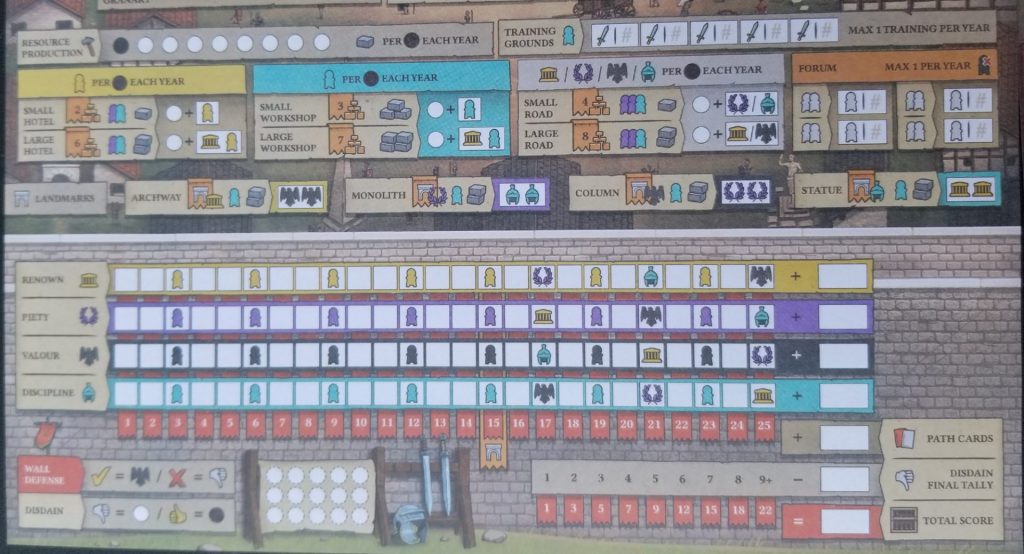
Next are the Resource Production and Training Grounds tracks. The further you are along the Resource Production track, the more bonus Resources you’ll earn at the beginning of the year. The Training Grounds track allows you, once per year, to send a blue worker to the Wall Guard track. Essentially, one of your builders has gotten pressed into military service.
Beneath these tracks are the Common buildings: the Hotel, Workshop, and the Road. These have certain requirements that must be met and resources and workers that must be paid to the supply before they can be built. Additionally, each of these has a small and a large version. The small version must be built before the large. Once built, these Common buildings provide the players with bonus workers and/or movement along the game’s Attribute tracks at the start of the year.
No game with so many random elements is good without some method of converting unwanted items into more desirable ones. Once per year, the player can use the next section, the Forum, to convert any 2 workers into a single worker of another type.
At the bottom of the left sheet are the Attribute tracks. There are 4 types of Attributes and this is the primary source of victory points. The further you have moved along these tracks, the more points they will earn you at the end of the game. Once you’ve reached 15 on each track, you’ll be eligible to construct a Landmark. After paying the cost and checking off the Landmark box, you’ll receive 2 free marks in a specific Attribute track.
The remainder of the left sheet is where the scoring occurs. There is a Disdain track where each failure to stave off the Picts will be recorded. These failures will cost you points at the end of the game. There are additional boxes here to record the victory point totals from the Attribute tracks and Path cards.
And Coming Up On Your Right…
Workers have families. They’re people just like you and me and they have needs. Each milecastle is supported by a village and it is in these villages where these needs are met. The right sheet is where this stuff happens.
The right sheet is divided into 5 different sections representing 5 types of civilian occupations: Traders, Performers, Priests, Apparitores, and Patricians. Each of these classes of civilians has its own track with its own bonuses. Progressing along these tracks also provides the players access to specialized areas.
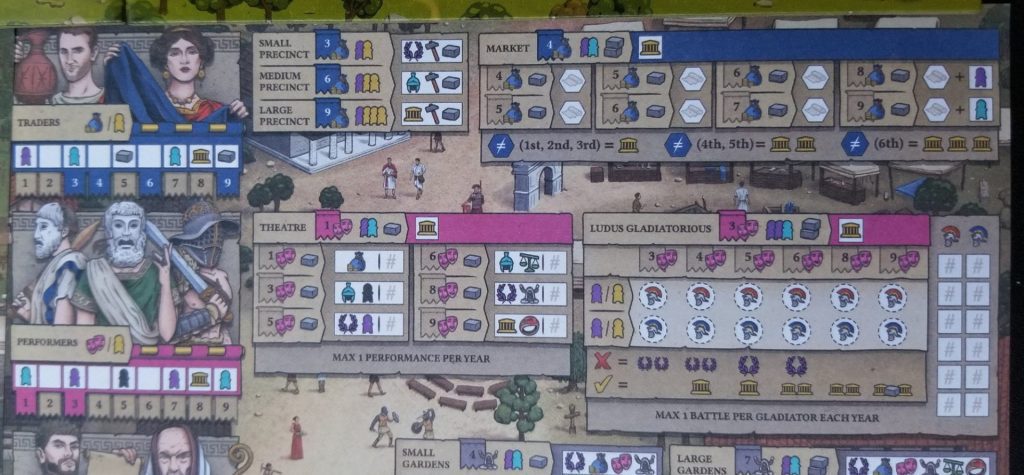
The Traders give players access to the Precincts and the Market. The Precincts don’t do much beyond rewarding several things at a time (a free mark on the Renown track, a mark on the Resource Production track, and a free resource, for instance). The Market gives the players a way to trade resources to their neighbors in return for Renown. They are trying to collect different numbers (the number shown next to the bolt of cloth on their neighbors’ face up cards). Collecting different numbers rewards Renown. The more unique numbers collected, the higher the reward.
The Performers give players access to the Theatre, where they can put on performances for rewards once per year, and the Ludus Gladiatorious (the Ludus). The Ludus is where the players will train their gladiators. Once their gladiators have grown in strength they can be sent out to fight in the arena. A Fate card is flipped up. The helmet with the number on the Fate card determines how much damage the player’s gladiator will receive. If the gladiator survives, the player will receive Renown. If the gladiator dies early in its career, the player will receive some free marks on the Piety track.

The Priests give players access to the Gardens (small and large), which reward free marks on multiple civilian tracks, as well as the Temples (small, medium, and large). The temples must be built in order from small to large and each must be filled in from top to bottom in order (top to bottom, small to large). Filling these in rewards the players with marks on the Piety track and, more importantly, Favour. Favour can be used in future turns to stave off a portion of a Pict attack.
The Apparitores provide access to the Baths, which reward the player with a Thumb icon (which negates a Disdain) and can be used twice per year, and also the Courthouse which can be used once per column per year. Filling in boxes in the Courthouse rewards the player with blue and/or purple workers.
Lastly, the Patricians open up access to Diplomats which reward free marks on the Valour track as well as Favour. Unlike the Priests, though, the Diplomats’ Favour is only applied to a specific cohort (which is selected at the time the Diplomat is filled in). Patricians also provide access to Scouts. This area of the right sheet features a grid of squares with different icons in some of the squares. Using the scouting action lets the player fill in the boxes using the grey square configuration shown on their own (or their neighbor’s) face up card. Filling in complete rows awards even more marks on the Valour track.
Haec Est Finis
As mentioned previously, the end of each year will see the Picts attacking. A number of Fate cards will be flipped determined by the chosen difficulty. To receive the full Valour reward (printed on the grey flag of the current year on the Player board), a player must fend off every single Pict. Each one that cannot be fended off results in a Disdain (up to the amount shown on the grey flag). If any attack gets through, the players receive Valour equal to the difference between the number on the grey flag and the amount of Disdain they received.
After the Picts have attacked at the end of the sixth year, the final scores are tallied. Players earn points for their current positions on each Attribute track as well as their Path cards. Players lose points for any Disdain they have collected that have not been negated. The higher the Disdain, the harsher the penalty becomes. The player with the most points wins.
Thoughts
Here at Meeple Mountain, we’re more than just a rag-tag group of writers. We’re a family. This is even more true for the large contingency of us that live here in the Nashville, Tennessee area. Living in such close proximity with one another not only bonds us together with common experience wrought from residing in the same city, but also from those opportunities when we are all able to gather in person and play games together.
It was on one such occasion several years ago that Andy Matthews introduced me to Ganz Schön Clever (GSC) for the first time. That was my first introduction to the modern ”roll and write”. Sitting at that table, little did I know that I was experiencing the first spark in a huge explosion in the board gaming industry. The concept of the “roll and write” was nothing new; Yahtzee’s been around since 1956 and more current games like Qwixx and Qwinto, for example, have enjoyed success. But GSC seems to have been the proverbial straw that broke the camel’s back. With GSC, the floodgates had opened and a seeming tidal wave of roll and writes burst forth.
Since that time I have played a lot of “roll and writes”. And just as deck building games like Dominion and Ascension inspired bag building games like Orleans and Automobiles, games like GSC inspired a new generation of designers to take that “roll and write” concept and tweak it giving rise to the “flip and fill” genre with popular titles such as Cartographers and Silver and Gold emerging as a result. To me, the genres are essentially the same; the “flip and fill” replacing dice with cards.
Cards, however, give you a lot more flexibility than a standard 6-sided die can. Never has that been demonstrated more effectively (at least in my opinion) than in Hadrian’s Wall. Each Fate card, for instance, contains 4 distinct pieces of information, a feat which you simply cannot reproduce with dice in any way that doesn’t involve rolling a massive fistful of them. You could make the argument that flipping over a card is just as random as rolling a handful of dice, but the big difference is that it doesn’t feel as random. In Hadrian’s Wall you’re never left feeling like you’re at the mercy of random chance. You always feel like you’re in control of your destiny.
And that right there is the key reason that I can definitively say that Hadrian’s Wall is the best game that I have ever played in the “roll and write/flip and fill” genre.
It comes down to choices and whether or not those choices you’re forced to make are interesting or meaningful. Hadrian’s Wall gives you a veritable smorgasbord of options to choose from and all of them are important. Each decision you make informs each decision that follows. Each decision in turn narrows down the scope of your remaining choices. It’s like a funnel channeling you down a specific path. This funneling is critical in a game like Hadrian’s Wall, a game that’s a massive sandbox of potential. There’s so much potential, in fact, that it has a tendency to overwhelm newer players. And that’s really its only weakness.
Hadrian’s Wall has a very large scope. With so many interconnected intricacies, teaching the game to people necessarily takes a decent chunk of time. As you listen to the rules explanation or, as was in my case, read through the instruction manual for the first time, you get an idea of the game’s complexity. But it isn’t until that first card gets flipped that you grasp just how vast the sea of decision space in the game really is. Thankfully you’ve got the Path cards to guide you. Like a gleaming lighthouse in a raging sea of opportunity, the Path cards provide you much needed guidance to help you chart your course. Were it not for this brilliant inclusion, I would be warding you away from this game.
I guess the take away from this is that, going into Hadrian’s Wall, you should be prepared for a challenge. It’s a tough nut to crack, but well worth the effort. I never expected to like this game as much as I do. I never thought I’d ever own any kind of “x and write” type of game where I’d ever begin giving serious thought to laminating the scoresheets lest I run completely out of them, but here we are. Hadrian’s Wall is so compelling and so much fun that I am always down for a play. I’m pretty confident that you’ll feel the same.


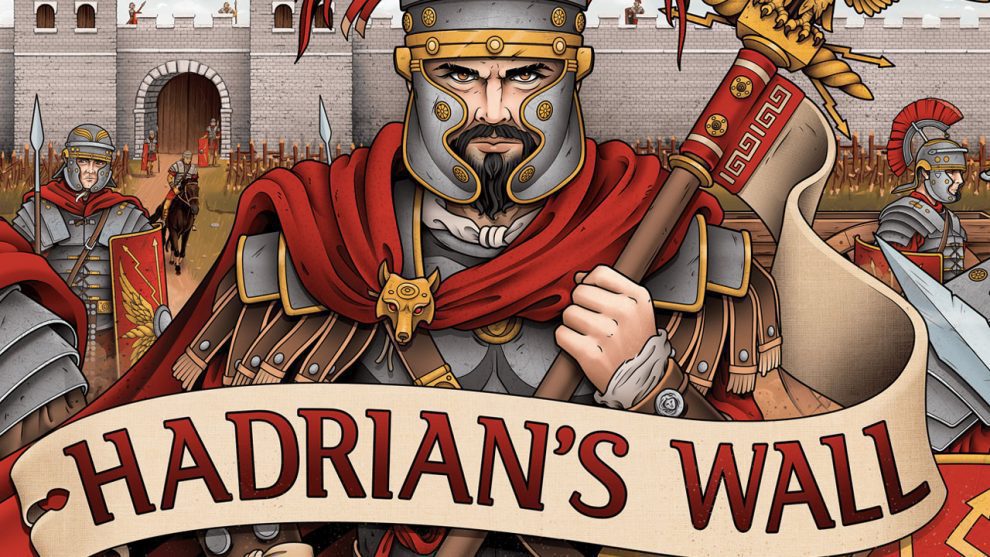

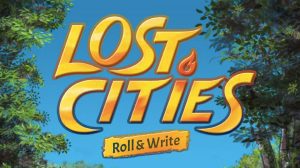

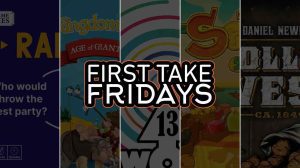





Add Comment